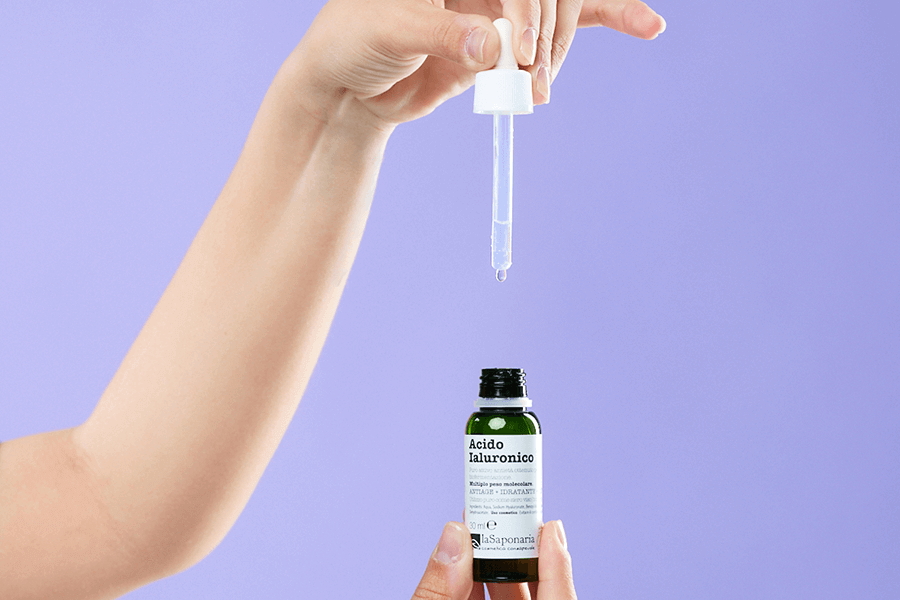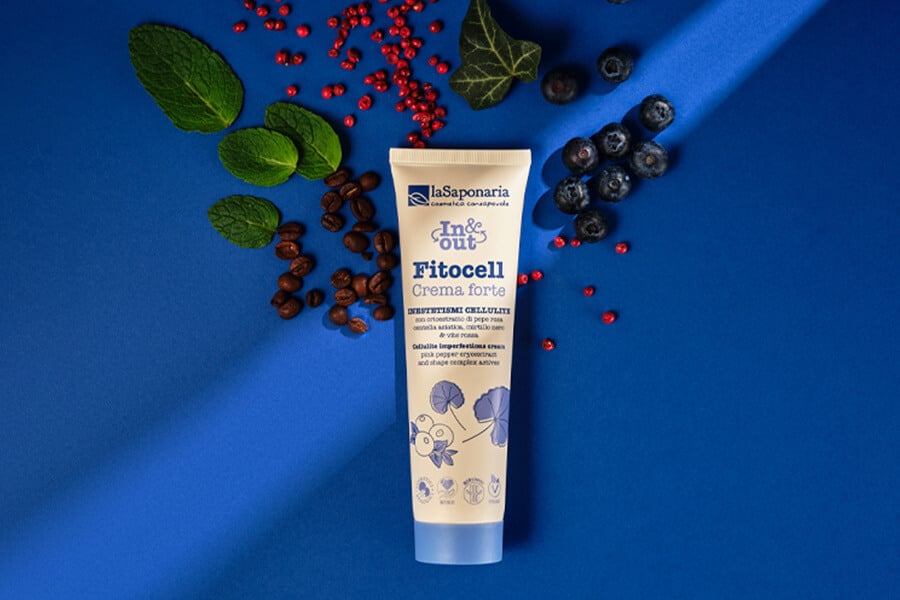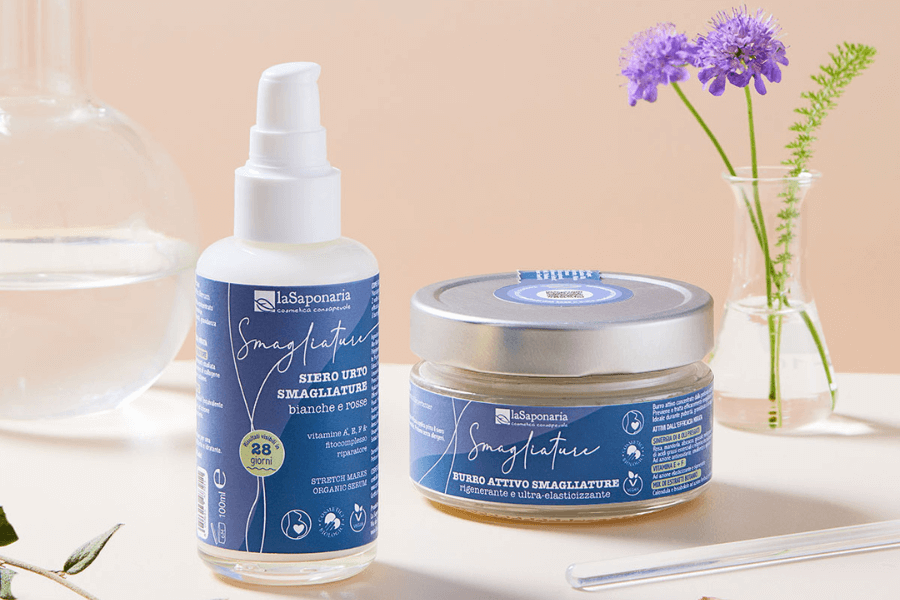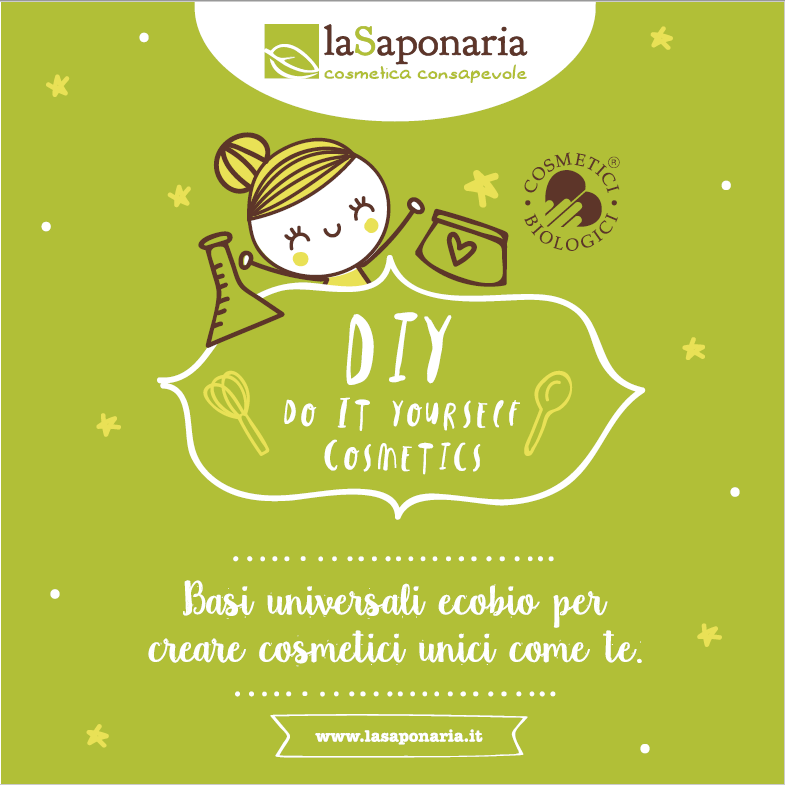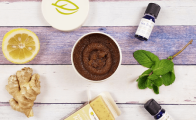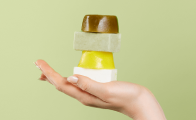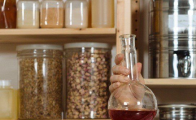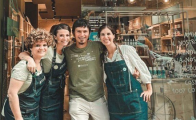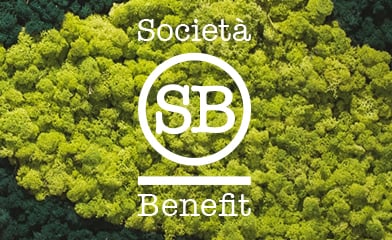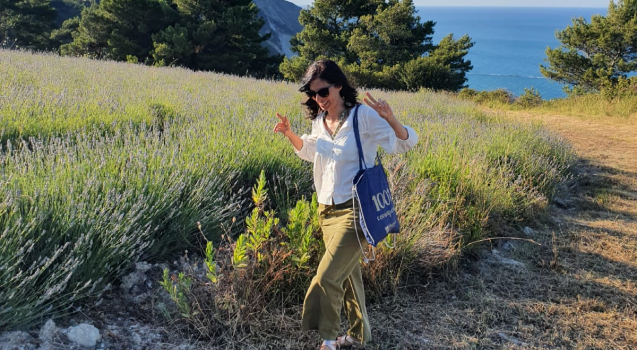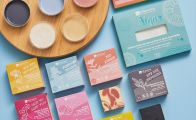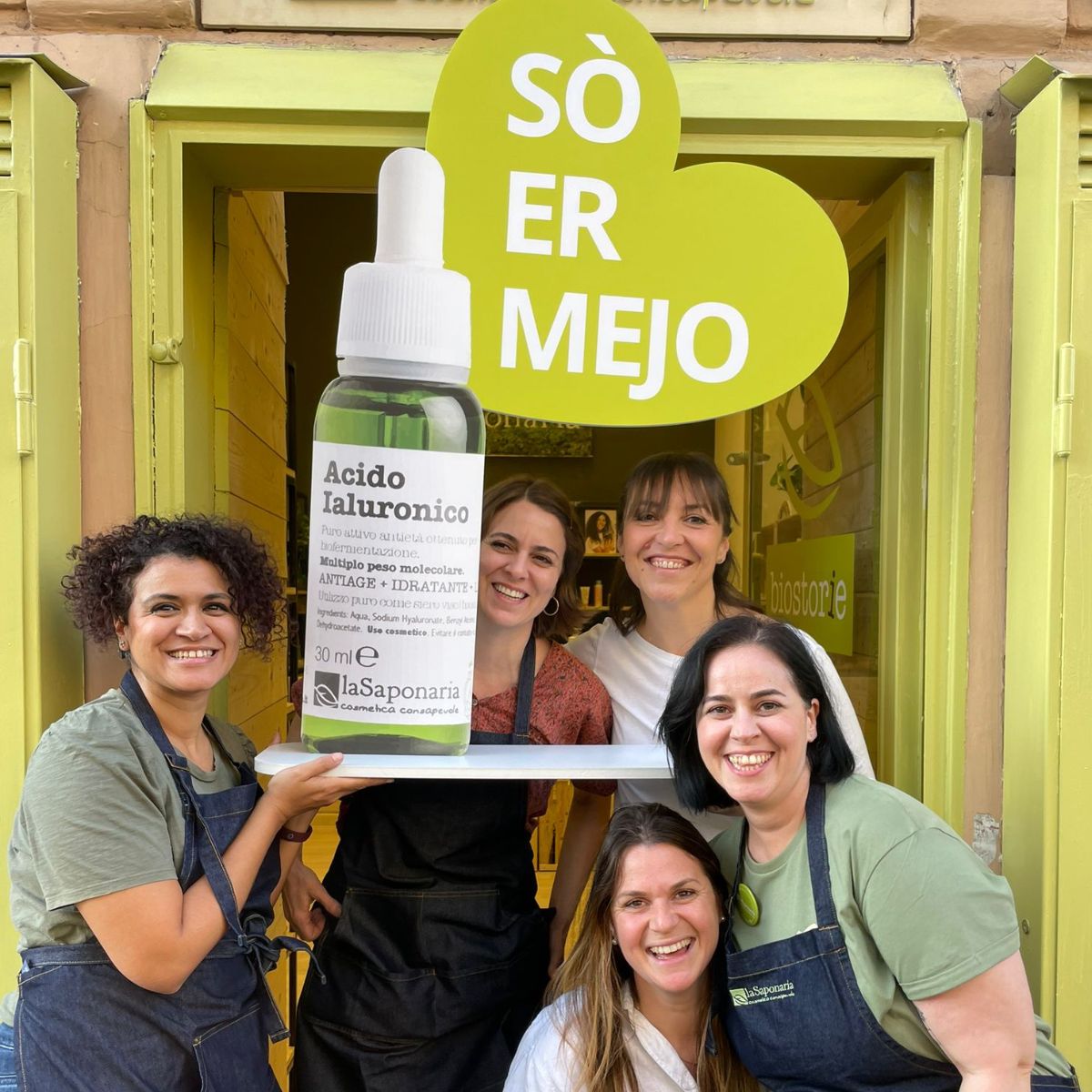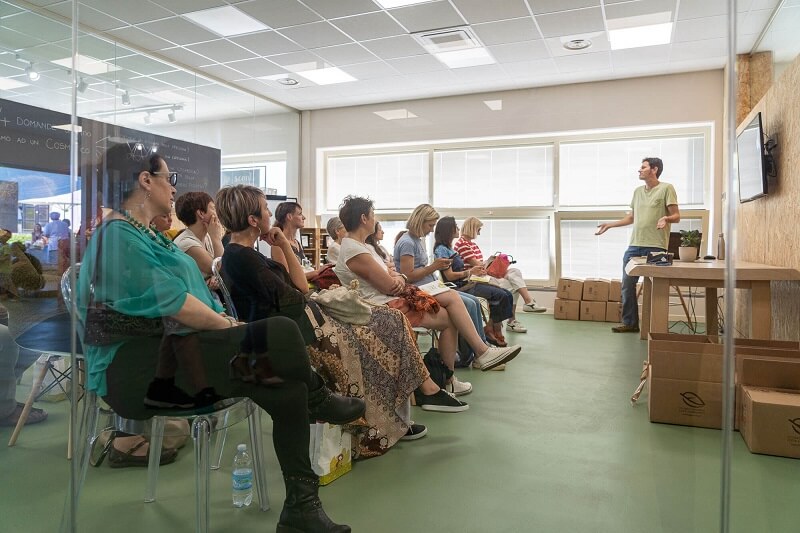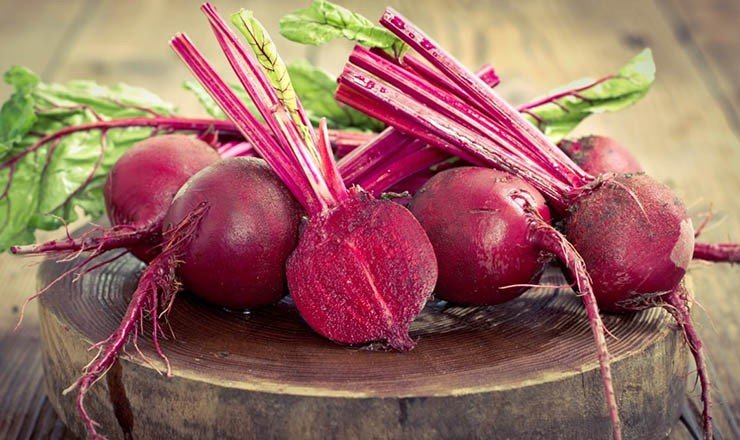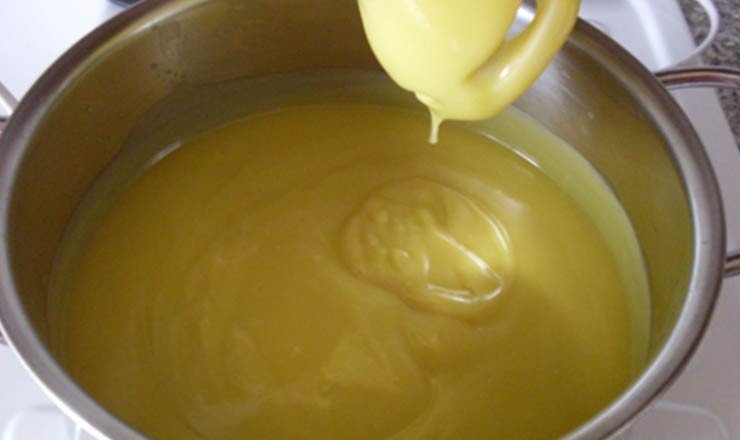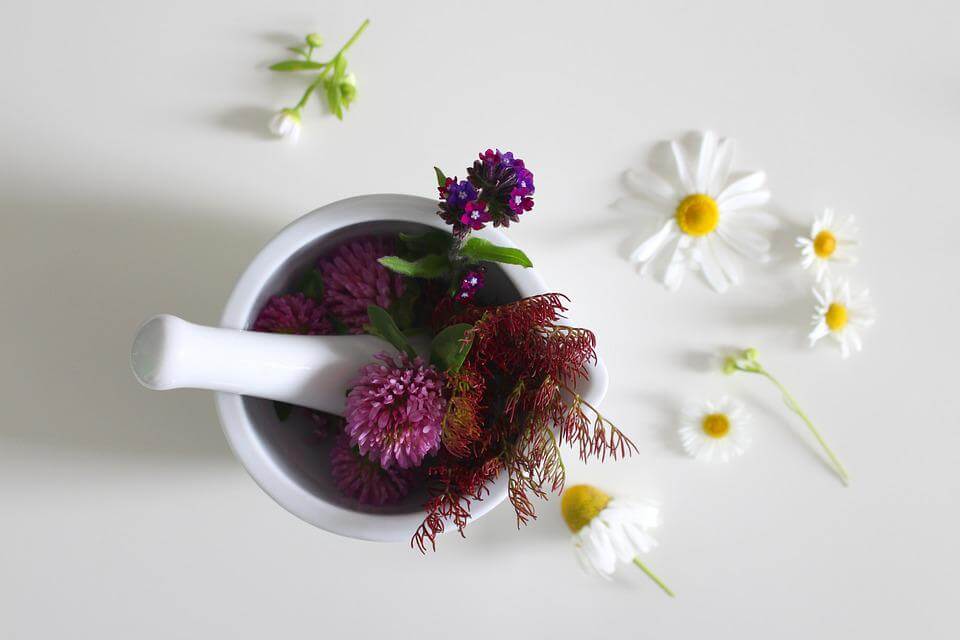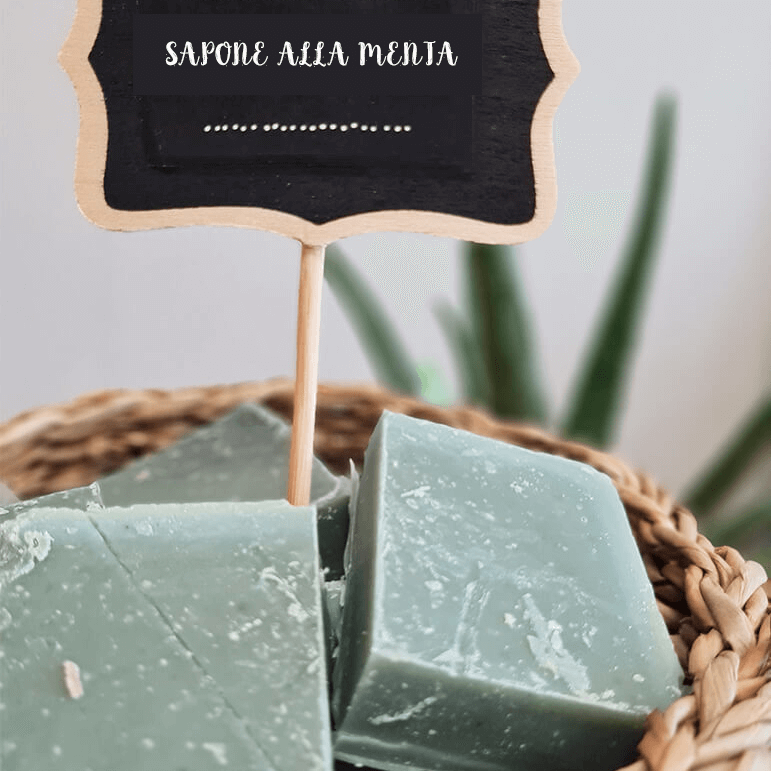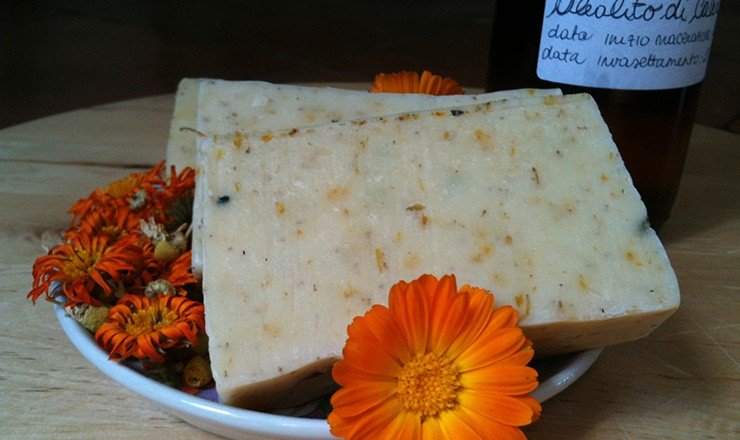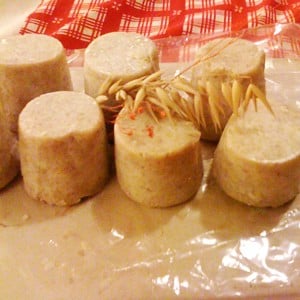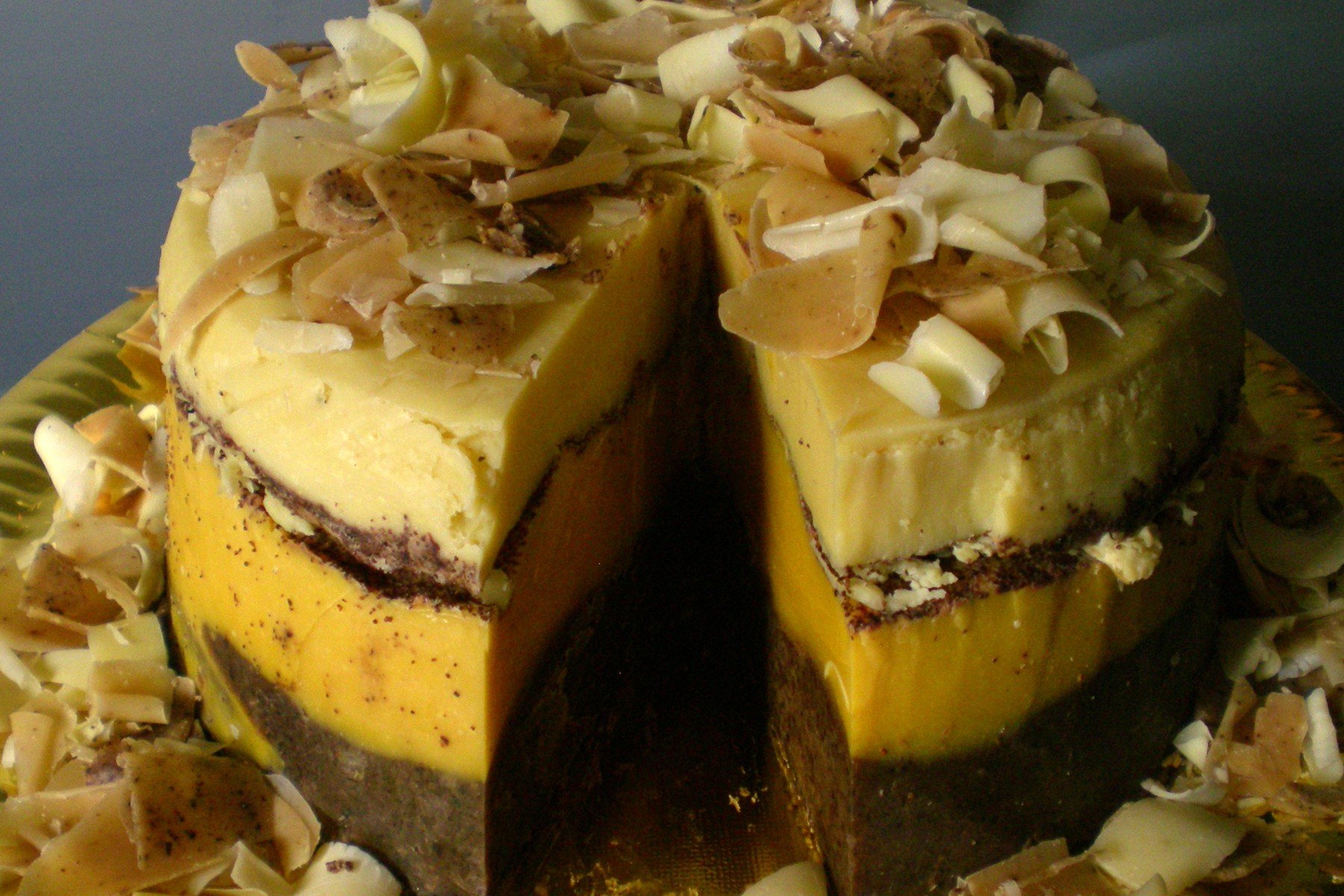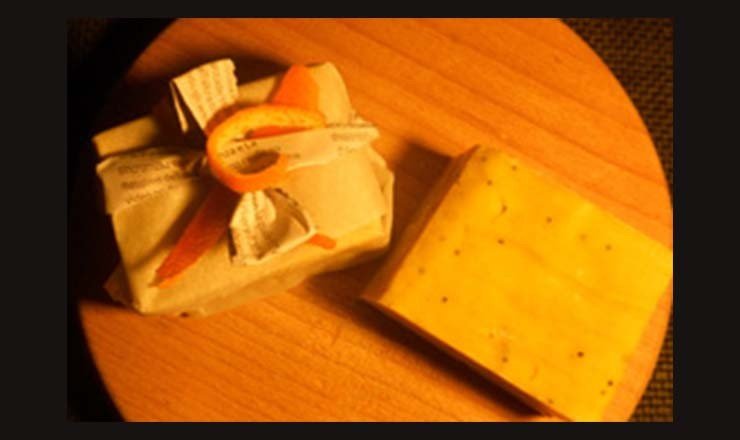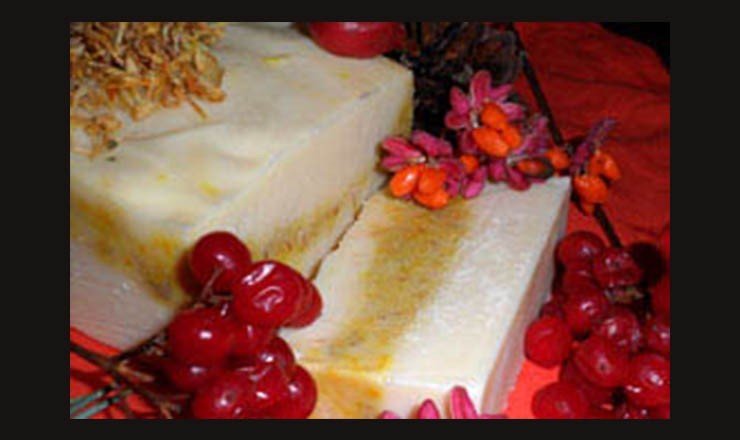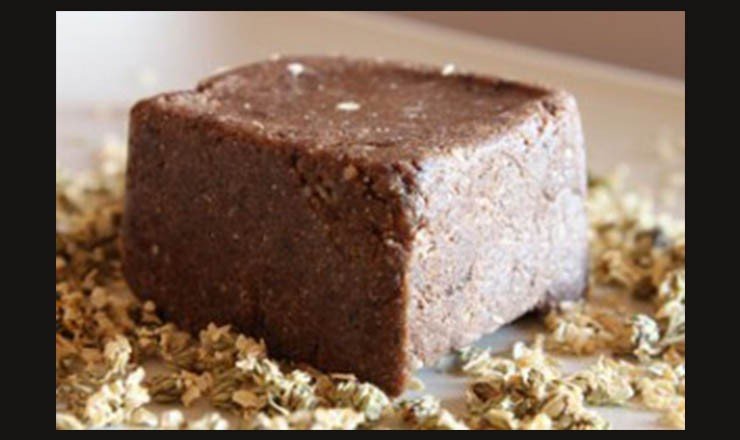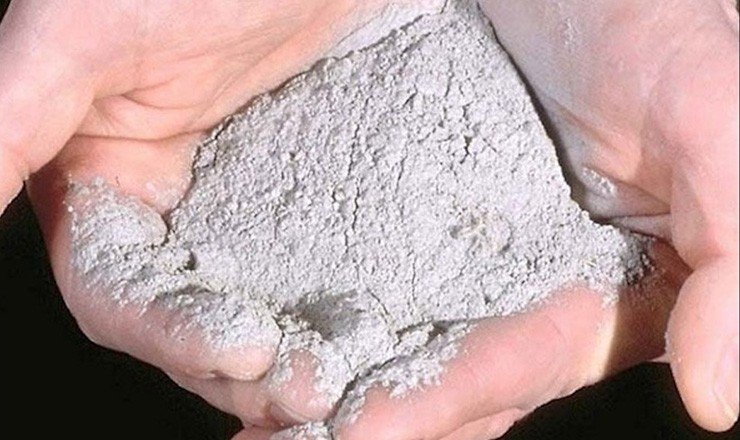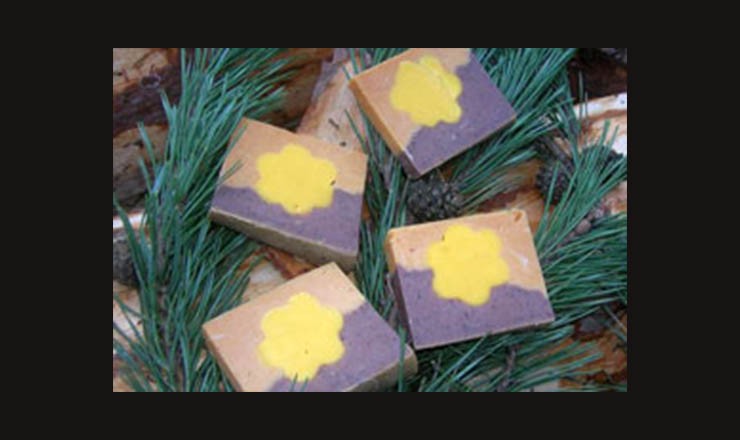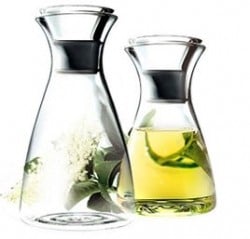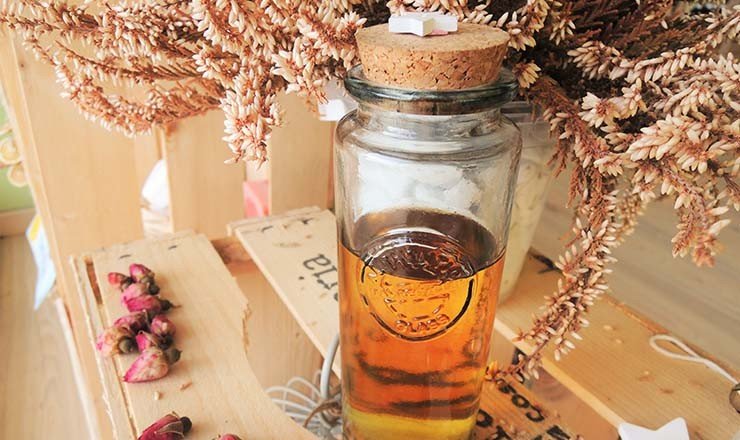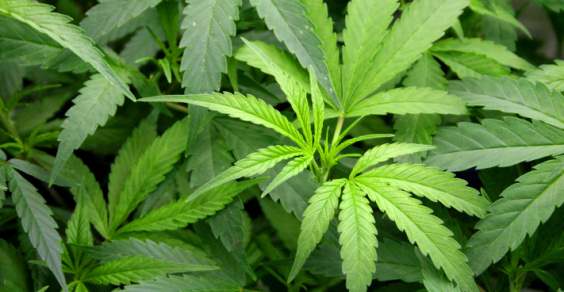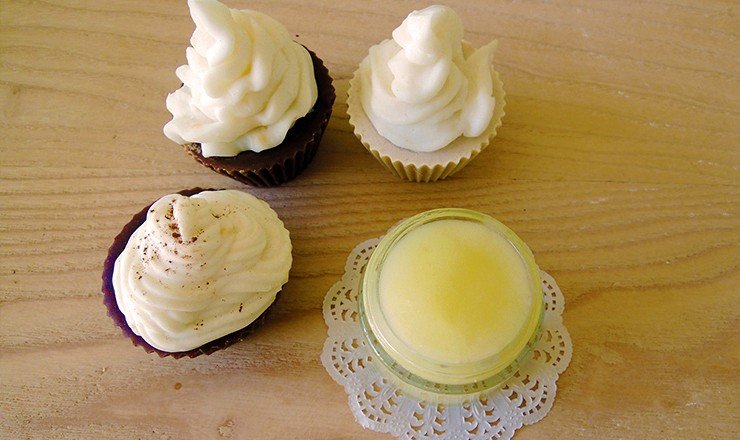Category: Soaps DIY recipes
Maybe the destiny of colored soaps with natural infusions is to become all shades ranging from whitish to yellowish and from yellowish to brownish.
At least that's what happened to my Christmas soap ...
I was studying a red soap with white dots, in full color theme… when red turnips came to mind. And those dried pale yellow flowers of helichrysum that I had stored somewhere in the house for future use.
I suspected that the pigments contained in the red turnip reacted with the basic caustic soda… and I was sure of this when the product was finished. The soap has turned pale greenish to brownish.
Here is a simple and cute recipe for making a home-made Marseille soap using the cold method. It was Elisa, a friend of ours who suggested it.
Making soap at home is easier and gives more satisfaction than what you think: there are two methods, the hot one and the cold one. We also talk about it in our book, "Il primo sapone non si scorda mai" (The first soap is never forgotten), where you can find many recipes to start self-producing in full autonomy and awareness
We use the cold method to make Marseille soap at home:
“It was back in 2007, I still didn't know that soon I would meet Lucia & Luigi. I was already taking my first steps into the magical (I'm not kidding!) world of soap making. I had this idea in my head of a large pot on the fire, and a huge ladle to turn and turn the dense substance that was bubbling hours and hours inside ... for me the fools who made soap at home looked a bit like Maga Magò and Amelia. Instead I met Rossella, my Soap Master who made me discover cold saponification. And in 20 minutes I already had my soap there to take shape in a plastic container. And then I met Lucia & Luigi, by the sea, with one of their first stands. And I realized that there were other fools like me messing around making soaps.
The satisfaction of making your own soap is priceless. It is truly magic. "
Do you love perfumes but struggle to find what really represents you? You can make it yourself, it's very easy! Look for an essential oil you like or create your own perfect mix. Alternatively, you can use the essences, which are a mix of essential oils and natural extracts already formulated to be balanced perfumes.
Preparing a solid perfume with essential oils or essences is really simple and immediate: here is everything you need to self-produce a 10 gram solid perfume
Here is the procedure for making your own homemade mint soap using the cold process. Always remember to work with gloves, goggles and an FFP3 filtering face mask. Enjoy the whole process!
We offer you another recipe that Laura has experimented for us: calendula and chamomile soap, emollient and anti-inflammatory, suitable for delicate skin!
But let's hear what our self-producing friend tells us:
”I would like to share with you one of my first recipes for home-made natural soaps. Driven by the desire to create a soap to use in the shower, that would avoid me buying shower gel and above all that would respond to the needs of my skin, I formulated this recipe thinking of one of my favorite flowers and which is best suited to my needs: the calendula. In fact, the main ingredient of this recipe is the marigold oil, very easy to self-produce at home, which embodies the anti-inflammatory, antiseptic and emollient properties of this beautiful flower; combined with the Chamomile infusion, it makes this soap suitable for those like me who have delicate skin, which tends to dry out and get irritated very easily. "
Some of you have "tasted" a small piece of it and were enthusiastic about it, others have asked us for more information on the soap cake that we created for the inauguration of the new website www.lasaponaria.it.
Given the great curiosity aroused, we decided to share the recipe with you!
In this recipe we will tell you step by step how to make a soap cake, an original idea as a gift to celebrate your anniversaries with relatives and friends instead of the classic dessert!
Our recipe for the "vegan lemon cream, almonds and coffee" cake
Olive oil, which is present for 65%, is self-produced and absolutely organic.
Recipe submitted to the "Saponi e buoi dei paesi tuoi" self-production contest. Why does it represent the proverb "saponi e buoi dei paesi tuoi?" I created this soap inspired by the enchanted forests and meadows of the Monti Sibillini that I have the joy of admiring from my windows every day. It's as white as the silent snow that soothes the souls of those who wander through the sleeping woods during the winter season. A yellow band runs through the middle, where some dried petals of calendula, chamomile, violet... are concentrated to remind us both of the sun's rays that penetrate the dense foliage of the woods, creating the fantastic sensation of being able to spot a fairy at any moment, and of the flowers that flood these mountains' meadows with shapes and colors in spring and summer. It's a gentle, refreshing soap that leaves the skin as soft as the waters of the countless streams that gush happily from those rocks. In honor of the "fairy" who has dwelled among these magical places for centuries and still fascinates even the most incredulous, I named it the Sibilla soap.
Recipe submitted for the "Saponi e buoi dei paesi tuoi" self-production contest. Why does it represent the proverb "Saponi e buoi dei paesi tuoi" (Soaps and oxen from your own country)? When asked about my hometown, I was taken aback.
Then I thought that we are what we eat, and immediately, Pizzocheri and Papina came to my mind, two dishes linked to my childhood (I believe I tasted the former when I was just a few months old). When I hear them mentioned, I feel a sense of belonging to these Lombard places... The flour I used for the soap dough is the same one used to make the famous Valtellina Pizzoccheri, made from buckwheat. The Valtellina has adopted me since I was a few months old, and I spent all my summer and winter vacations there until I was 20 (nowadays, I only return for special occasions or in the summer when Milan is way too hot!). Then there's Papina, the traditional cake of Brianza tradition, which my mom often cooked (and still does, I believe). But not just my mom: in fact, a vegan version, super energizing but light (and also sugar-free), came to life in my kitchen a few days ago... And that's how it all comes together. The cocoa is a clear reference to the cake, just like the dates and prunes that replace the raisins, which I don't like (besides, they are my favorite fruits: prunes in the summer and dates during this season – even now as I write :)). To give it the shape of a "cake slice," I put the dough in a small plastic container with a cubic shape: at local fairs, Papina is cut and served in little cubes. I placed the resulting soap dough on a bed of Erba Livia: the same fields where, as a child, I used to lie down to catch my breath after running around (it's a type of grass that grows in the high mountains). I can almost smell it... In fact, as I take photos, I can! It somewhat resembles the scent of sage and lavender. Erba Livia is a typical herb from the valley, used as an infusion to soothe the stomach. I suggest putting it in the container along with the soap dough to relax the senses before the shower.
When in the 60s I went with friends for a picnic "out of town" to the Roman Castles, we played in the meadows and chestnut woods, falling and rolling among the mint plants that grow there wherever there was a little sun and then we stopped in some trattoria where in the warmth of the fireplace we all ate together at a wooden table the pecorino romano and the porchetta from Ariccia with wild cicely. The mint and cicely soap is made with extra virgin olive oil from our region with the addition of Roman mint leaves and wild cicely flowers collected by me during the summer and dried. The soap mold recalls the shapes of pecorino romano and from this derives the name sapo-rino. Table salt causes the soap to dry very quickly. Even if the soap can be used immediately, it is best to let it dry for at least 15 days. Coconut oil is used to create foam. The yellow / green dotted color is given by the added dried plants.
Why does it represent the proverb "Saponi e buoi dei paesi tuoi"? Resia is a valley located in the easternmost corner of Friuli, nestled between Austria and Slovenia. It is home to a unique population in terms of language and culture, expressed through music, dances, traditions, and truly special folk festivals! In our language (Resian), "Val Resia" means Valley of Flowers. The valley is indeed an explosion of colors and scents from over 1200 plants (species and subspecies) found in the area, some of which are endemic.
To represent it, I chose a combination of colors and ingredients:
Brown to celebrate the land: rich and generous.
The central yellow flower to symbolize some of these flowers: St. John's wort, arnica, primroses, dandelion, goldenrod, calendula...
Honey, castor wax, lavender, and almonds: precious gifts from my beloved land.

